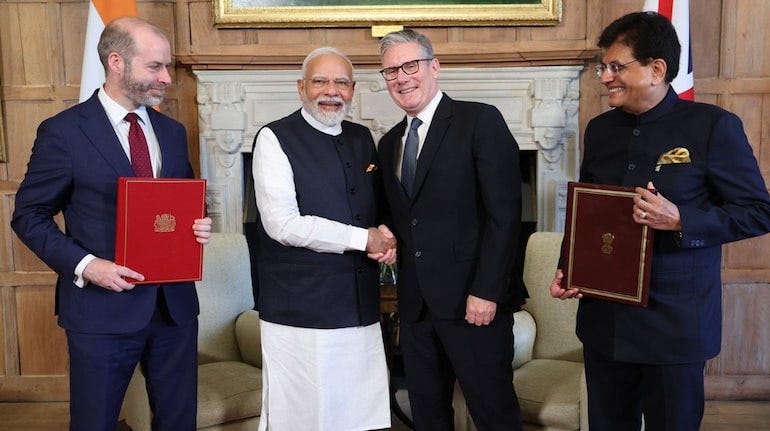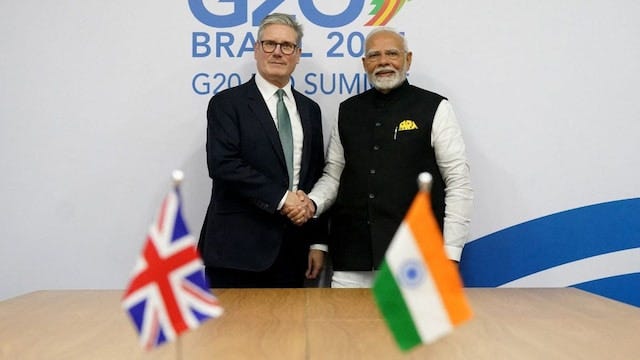#330: India-UK FTA
Notes for your notes :)
Goal: $100B Trade Future
Why It Matters?
The India-UK Vision 2035 and the Comprehensive Economic and Trade Agreement (CETA), unveiled during the Indian PM’s London visit, aim to skyrocket bilateral trade to over $100 billion by 2030, cementing a transformative partnership.
India-UK Vision 2035: Key Pillars
- Trade & Economy: CETA drives trade growth and job creation, overseen by the Joint Economic and Trade Committee (JETCO), with a Bilateral Investment Treaty in progress.
- Tech & Innovation: The Technology Security Initiative targets AI, quantum computing, telecom, and critical minerals.
- Defense: A 10-year roadmap boosts joint research in jet engines, maritime security, and directed energy weapons, with a UK-India Regional Maritime Security Centre to counter non-traditional threats.
- Climate & Sustainability: Joint efforts in green finance, offshore wind, nuclear tech, and supply chains, leveraging platforms like the International Solar Alliance.
- Education & Skills: UK university campuses in India, Mutual Recognition of Qualifications, and a Green Skills Partnership to create climate-focused jobs.
- Global Governance: Commitment to reforming global institutions like the UN, WTO, IMF, and World Bank.
CETA Highlights
- Duty-Free Access: 99% duty-free access for India to UK markets, boosting textiles, leather, marine products, and EVs. India cuts duties on 90% of UK imports, including cars and alcohol.
- Services Sector: Enhanced access for Indian IT, financial, and professional services, with simplified visas.
- Double Contribution Convention: Indian professionals exempt from UK social security contributions for three years.
- Inclusive Growth: Empowers women, youth, MSMEs, farmers, and innovators in global value chains.
- Agricultural Boost: Tariff cuts on Indian processed foods, edible oils, and seafood.
- Impact: Aims to double trade to $112 billion by 2030, increase UK exports to India by 60% by 2040, and spur jobs and investment.
Evolution of India-UK Ties
- Trade: Bilateral trade hit $21.34 billion in 2023–24, with India’s exports up 12.6% to $14.5 billion in 2024–25.
- Tech: The 2024 Technology Security Initiative focuses on AI, semiconductors, and green hydrogen. The UK is India’s second-largest research partner.
- Defense: Joint exercises (Konkan, Cobra Warrior) and Indo-Pacific collaboration strengthen ties.
- Health: Covid-19 vaccine partnerships and 60,000 Indian NHS workers highlight health cooperation.
- Diaspora: 1.86 million Indian-origin people drive UK’s science, arts, and politics.
Points of Tension
- Extradition: UK’s reluctance to extradite fugitives like Vijay Mallya strains trust.
- Russia-Ukraine: India’s neutrality contrasts with UK’s pro-Ukraine stance.
- Climate Tariffs: UK’s Carbon Border Adjustment Mechanism could hit Indian steel exports.
- Khalistani Protests: India seeks stronger UK action against pro-Khalistani groups.
- IP Rights: UK’s strict IP rules clash with India’s need for affordable medicines.
Steps to Strengthen Ties
- Security: Deepen Indo-Pacific and counterterrorism cooperation, leveraging AUKUS.
- Climate: Collaborate on clean energy and sustainable agriculture.
- Trade: Expand market access and position India as a Global Capability Centre hub.
- Diaspora: Engage the Indian community for cultural and economic outreach.
Conclusion
The India-UK Vision 2035 and CETA herald a new era of economic, technological, and strategic collaboration. By navigating policy differences and leveraging shared strengths, both nations can build a robust, future-ready partnership.



